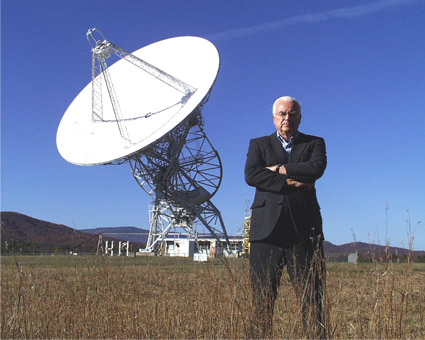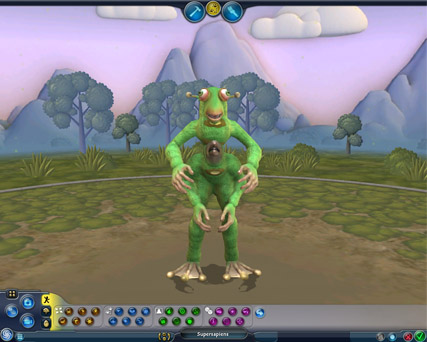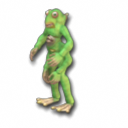Frank Drake


Blog Post - for SETI Institute, September 9 2008
By: Frank Drake
Frank Drake, the founder of the SETI project, is an American astronomer and astrophysicist. He has been searching for aliens throughout his career. Here he shares his latest thoughts on what extra terrestrials might look like.

"Thoughts about the forms of extraterrestrial creatures -
In my long SETI career, I have given hundreds of lectures about the search for ET. Two questions seem to be foremost on the minds of the listeners: "If humans vanished from the Earth, what would replace us?", and "What will the ET's look like?"
With regard to first question, there are already on Earth good candidate species which, with a little boost in intelligence, might replace us. The dolphins come to mind, although it is unlikely as an aquatic species they would ever produce a technology detectable over interstellar distances. They have no extremities which can handle tools, and little or no access to fire and hence metals.
The better candidates are the obvious ones, the primates similar to ourselves, particularly the chimpanzees. The chimps are very close to us in genome and intelligence, dexterity and also in social systems. This is the obvious choice to present in lectures. But sometimes, when I am in a whimsical mood, I surprise the audience by stating, in as authoritarian voice as I can, "Squirrels!!! This always wakes the audience up. I explain that, after all, the squirrels already stand on two feet, they are superb at manipulating things with their "hands," and they can outsmart any human when it comes to gaining access to a bird feeder! Take away the humans, and the squirrels might take over the world!
Once, at Arecibo, after a long day of interviews in the blazing sun for a CBS TV special, I proposed this possibility. It was fun to watch the expressions on the faces of Charles Osgood and the CBS crew --- I could tell that they were silently thinking "Is he kidding us?" -- or "is he serious??" - or "has the hot sun made him crazy?". Nothing was said and we moved on. I wondered what they would do with that piece of videotape. When the prime-time special finally aired, I watched to see what they had done with my proposal. Lo, not only was my statement there, but it was followed by a beautiful photo of an elegant squirrel, standing upright, dressed up in a tuxedo!

As to what will the ETs look like, there is only one certainty, and that is that they will not be duplicates of us. The long series of small mutations which lead to our present physiology will not be repeated exactly anywhere, despite the enormous number of habitable planets which exist.
There will be a tremendous variety of forms of intelligent creatures. Nevertheless, we are a good design for a planet like the Earth. Standing upright is very useful in detecting prey and predators, especially when we lived in the savannahs. This allows us to have limbs which are free to manipulate things, especially tools when we became a tool-using creature. Having the head and eyes on top is, similarly, a great help in observing the world around us. The eyes need to be in the head so that the neural connections from the eyes to the brain are as short as possible. Because of this basically very effective design, I often say that were we to observe other intelligent species in the twilight at a distance of a hundred yards or so, we might think they are human. But when we got close to them, it would be clear that they weren't.
Sometimes our good design makes us think that our design is optimum. But it isn't - it is an adaptation of an ancient four limbed ancestor which was not designed to be a tool maker. In a more optimum design, we would have four arms instead of two - if we had evolved from a six limbed creature, as did insects, this would have happened. It is not unlikely. Four arms would solve a lot of problems when we are trying to carry bags of groceries in from the car! Another not very successful adaptation we live with is the sharing of one "tube" for breathing, eating, and talking. It makes it possible to choke to death when eating and requires a long esophagus which is prone to disease such as heartburn.
A better design would have a separate mouth close to the stomach, with a second tube to serve the breathing and speaking function. This arrangement exists in many aquatic animals, but we didn't evolve from them. So it could well be that we are a rare form of ET, and the more successful ones will have four arms and a mouth at the stomach. And, better still, an eye in the back of the head, which would clearly be a very advantageous addition, especially for mothers who need to watch mischievous children.

Recently I had an opportunity to design my version of the optimum ET. I did that with the recently released video game, "Creature Creator," which can be found also in the much larger game, "Spore."
My ET has four arms, a mouth right at the stomach, and an eye in the back of its head. Oh, yes, and two other embellishments. Green skin containing chlorophyll, so that the creature can manufacture some of its own food from air and water through photosynthesis (little green men make a lot of sense!), and web feet to make swimming more fun.
I named my creature "Supersapiens" because it is a super version of our species, homo sapiens. If you have access to Spore or the Spore Creature Creator, you can find it in the "Sporepedia."
For more information please visit www.seti.org.


































